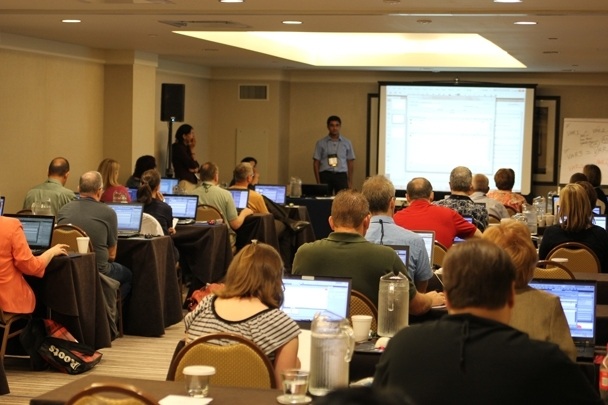e-Learning: Challenges and Solutions
In order to understand the challenges associated with an e-learning environment it is important to define what the term e-learning means. Clark and Mayer help define e-learning as instruction delivered by any technological mode intended to promote learning (2011). Teaching and learning in an e-learning environment happens differently than in the traditional classroom and can present new challenges to instructors and learners participating in this online learning environment. Technology-assisted learning tools is quickly changing the face of education, transitioning the classroom only learning environment to an online only or blended online learning experience.
The possible challenges instructors and learners face in an e-learning environment must be considered in order to ensure learner success. Therefore, there are two roles in e-learning that must be considered when discussing ways to improve these challenges. The first is the instructor’s role and the second, the student’s role. Both roles include a transition away from traditional teacher-student relationships, roles, and responsibilities, to virtual space roles. However, it is the instructor’s primary roles within the learning environment, which will help overcome challenges, support, and sustain student success.
The New Digital Divide
In education, the digital divide is most commonly defined as the gap between those students who have, do not have, and know how to use the internet and the information technologies that are currently transforming education (Bernard, 2011; Hall, 2013). According to Warschauer (2003), the “digital divide is marked not only by physical access to computers and connectivity but also by access to the additional resources that allow people to use technology well” (p. 6). Due to the affordability of many information technologies today the current meaning of digital divide is changing from having access, to knowing how to use the technologies (Bernard, 2011). In this way the digital divide still acts as a challenge for education and more specifically e-learning environments. In education the digital divide has, most recently, become more about closing the gap between using the resources appropriately to obtain quality educational outcomes than not having access to the technology (Warschauer, 2003; Bernard, 2011). The quality of learning outcomes, and more importantly the successful use of the expected technology resources, all hinge on the amount of experience and comfort level each learner has with these specific resource technologies (Warschauer, 2003).
One solution to this challenge is for the instructor to implement a learning environment that encourages collaboration. Providing learners with the opportunity to collaborate, share, and create will increase the learner’s use of various technologies, enhance their e-learning experience, and support self-directed and ongoing learning (Clark & Mayer, 2011; Li & Irby, 2008). During this time the instructor must consider the learner’s technological incompetence’s and accept various ability levels; willing to allow learners choice with the expected performance objectives given it results in the appropriate learning outcomes (Bernard, 2011). The learner should ask questions, seek additional information from credible sources, reflect often, and interact with other learners in academic discourse related to the online learning objectives. Having an online community where learners can collaborate in a safe and respected learning environment will help close the gap of the new digital divide, and in doing so helps to create a culture of digital natives conducive to effective e-learning (Warschauer, 2003; Li & Irby, 2008; Clark & Mayer, 2011).
Student Motivation
Although student motivation can only truly happen intrinsically, creating the right online environment where students want to learn and feel successful is the primary the responsibility of the instructor or course designer. According to Martin, in today’s online environments there is a lack of teacher presence, face-to-face (f2f) interaction, and tech support (2009). The most well planned and explicitly laid out online instructional environment is not enough to sustain learner interest or support intrinsic motivation. On the other hand learners new to an online learning environment typically lack the level of metacognition awareness, time management skills, and self-directed learning needed to be successful (Martin, 2009).
To promote student motivation the primary role falls to the teacher to anticipate and prevent motivational challenges unique to e-learning. One way this can be done is by increasing f2f interactions through a variety of technological modes (Martin, 2009). Online learning does not have to be isolated to merely email communication and web based only classroom interactions. Learners often have anxiety about learning online and need to feel connected, reassured, and safe to contribute in their new learning environments (Terry & Leppa, 2009; Hastie, Hung, Chen, & Kinshuk (2010). E-learning environments often lack a variety of communication options creating an unwelcoming online learning atmosphere (Terry & Leppa, 2009; Martin, 2009; Hastie et al., 2010), which only the instructor can control. To help alleviate student anxiety e-mentors should provide various and alternative ways of interacting and communicate through the use of such applications like Skype, chat forums, or discussion boards.
Course Design
Insufficient time spent on course development and design can be a huge contributing factor to poorly developed online learning experiences and a major challenge for e-learning instructors. According to Leanna Archambault (2010), the amount of time needed to design and implement a well design lesson, online, is an important consideration. Archambault indicated that instructors reported an increase in the amount of time they spent creating e-learning courses because of new content, new technologies, and new ways of engaging online learners.
One way to overcome the challenge of time developing an online course is for instructors to collaborate often within their e-learning professional communities. Collaborating with other instructors should be spent sharing, developing, and creating (Terry & Leppa, 2009; Hastie et al., 2010). This collaboration and discourse helps minimize the time spent planning and designing. A way to overcome the challenge of a well-developed overall course design should be addressed with the learner in mind and should include these overall course characteristics: (a) opportunities for learners to collaborate, (b) a well-established protocol for communicating, (c) clear performance expectations, and (d) opportunities for learners to chose the mode in which assignments are created and presented (Hastie et al., 2010). In order for instructors and learners to be successful these characteristics are essential to the overall course design and e-learning environment.
Conclusion
With so many different ways to define e-learning and the educational approaches that can be taken in these learning environments, it is the conclusion of this author that e-learning is an innovative approach to learning. It is a holistic way of teaching and learning that meets the needs of today’s digital natives. It is an environment made up of collaboration, choice, and an array of technological resources that supports a successful online learning experience. However, in order for learners to be successful in this learning environment the challenges to e-learning must be overcome with support and a best practice solutions. Instructors and learners must embrace the shift away from traditional classroom practices to an e-learning approach to education. Despite the fact that today’s learners are digital natives, the use of technology for e-learning can be overwhelming and provide student motivation challenges however, with the proper supports from instructors, learners can be successful within these e-learning environments. Finally, and probably the most important challenge for the instructor is to focus on the overall elements of a well-developed course. Developing a purposeful and well-defined online course, which supports the instructor and learner, means devoting the appropriate time and embedding the applicable course elements into the e-learning environment.
References
- Archambault, L. (2010). Identifying and addressing teaching challenges in k-12 online environments. Distance Learning, 7(2), pp. 13-17. Retrieved from http://proxy1.ncu.edu/login?url//search.ebscohost.com/login.aspx?direct=true&db=ofs&AN=52847127&site=eds-live
- Bernard, S. (2011, August 8). Crossing the digital divide: Bridges and barriers to digital inclusion. Edutopia. Retrieved from http://www.edutopia.org/digital-divide-technology-access-inclusion
- Clark, R., & Mayer, R. E. (2011). E-learning and the science of instruction [electronicresource]: proven guidelines for consumers and designers of multimedia learning / Ruth Colvin Clark, Richard E. Mayer. San Francisco, Calif. : Pfeiffer, 2011. Hall, B. (2013, May 17). Smartphones have bridged the digital divide[Web blog]. Retrieved from http://readwrite.com/2013/05/17/smartphones-have-bridged-the-digital-divide#feed=/author/brian-s-hall&awesm=~o9sE3cAylgBANm
- Hastie, M., Hung, I., Chen, N., & Kinshuk (2010). A blended synchronous learning model for educational international collaboration. Innovations in Education and Teaching International, 47(1), pp. 9-24. DOI: 10.1080/14703290903525812
- Li, C., & Irby, B. (2008). An overview of online education: Attractiveness, benefits, challenges, concerns and recommendations. College Student Journal, 42(2), pp. 449-458. Retrieved from http://proxy1.ncu.edu/login?url=http://search.ebscohost.com/login.aspx?direct=true&db=s3h&AN=32544879&site=eds-live
- Martin, J. (2009). Developing course material for online adult instruction. Merlot Journal of Online Learning, 5(2). Retrieved from http://jolt.merlot.org/vol5no2/martin_0609.htm
- Warschauer, M. (2003). Technology and social inclusion [electronic resource] : rethinking thedigital divide / Mark Warschauer. Cambridge, Mass. : MIT Press, c2003. Retrieved from http://proxy1.ncu.edu/login?url=http://search.ebscohost.com/login.aspx?direct=true&db=cat01034a&AN=nu.10225286&site=eds-live









